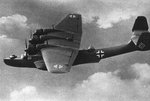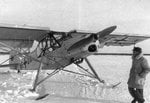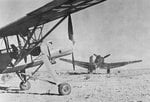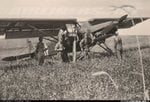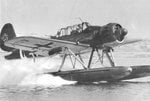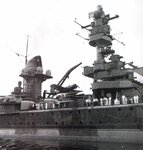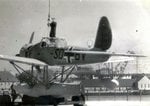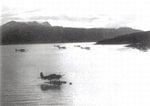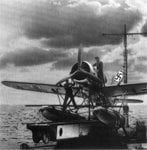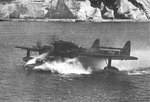Blohm Voss Ha-139
It was in the middle of the 1930s, when the Deutsche Lufthansa, that operated already a veritable far-distance mail transportation service via North and South Atlantic, needed a modern, catapultable long-range seaplane. Among the primary claims there was a payload of 400 kg, a range of 5,000 km and a cruising speed of 250 kph. This range was necessary to manage the distance of 3,850 km between Horta on the Azores and New York at a headwind of 60 kph. Also demanded was high seaworthiness, because landings on the open seas had been always to be calculated.
Lead by Dr. Richard Vogt, chief constructor of Hamburger Flugzeugbau, some drafts were submitted to the Deutsche Lufthansa. The one project named P.17, equipped with two floats, was accepted by the technical heads of the airline. The demanded high performances required small sizes of the airplane. After the drafting was finished, Hamburger Flugzeugbau got the order to manufacture three prototypes under the type deignation Ha 139. For propulsion, Jumo 205C Diesel engines were chosen, for their specifically few fuel consumption (165 g / PS *h). They had a take-off performance of 600 hp. The demanded high safety resulted in the installation of 4 engines. The aerodynamical valuability of the concept allowed to fly with only two engines, with reduced payload. The wing was formed with a bend to keep cockpit and tail surfaces away from splashing water. Like usually in Dr. Vogt's designs, the wing structure was a steel-tube spar, which contained five fuel tanks with a capacity of 6,500 l. The wing contained of three parts, had a span of 27 m and a constant depth of 4.5 m. The outer wing ankle was 7 degrees. The fuselage had an oval cross section. The crew consisted of four or five. The vertical stabilizer also had a constant depth and was strutted against the fuselage. The horizontal fins were formed as disks, changed more than one time and equipped with an aerodynamical balance. The fin cover was metal, while the rudders were covered with fabric. All rudders were equipped with trim flaps, while the inner wing had hydraulically operated spreading flaps. The fixing of the engines was done in a new system what resulted in a very smooth running.
The Ha 139 V1 registered D-AMIE "Nordmeer" (= "Northern Sea"), facility no. 181, was finished during late summer 1936 and had its successfull maiden flight in October of this year. The calculated flight performances were surpassed. The Ha 139 V2 registered D-AJEY "Nordwind" (= "Northern Wind"), facility no. 182, became ready at the same time, and both machines were taken over by the Lufthansa in March 1937. "Nordmeer" took off on August 15th, 1937, catapulted from the Lufthansa catapult ship "Friesenland" laying off the Azores, to her first Atlantic flight. After 16 1/2 hours, she landed in Port Washington, the seaplane station off New York. For the return flight, the catapult ship "Schwabenland" off Long Island was used (the original article mentions again the "Friesenland", what is impossible. The "Schwabenland" is the sister ship, I hope I don't confuse them). Until end of November 1937, another thirteen flights were successfully performed by both machines. Although the Ha 139 proved exceptionally, some changes, in engine radiation and vertical rudders were necessary. All complaints found their respect also in the manufacturing od the third sample, Ha 139 V3 registered D-ASTA "Nordstern" (= "Northern Star"), facility no. 217, that should be the prototype of the planned B series and was finished beginning of 1938. "Nordstern" also was thoroughly tested on the Northern route between July and October 1938.
Then, all three machines were used, first on the Horta-New York line and later in regular line service between Bathurst in Western Africa and Recife in Brasil. Now it was possible to restrain from catapulting, the improvements made even take-offs on overload and rough sea possible. In June 1939 the 100th crossing of the Atlantic Ocean was performed, so it could be proved that there was no more obstacle for any airline service to North and South America.
Not included in the original article is the reason why the North Atlantic route was closed down. Contrary to the situation now, in the late 30s there was no mutual air traffic agreement between the USA and the European countries. An admission of the US authorities was required. We have to speculate that the visits of European aircraft in the USA was not just welcome. Only some weeks before the Ha 139 did their last flights on the northern route, on August 10th to 11th, 1938, a FW 200 had made a non-stop flight from Berlin to New York. Shortly after this, the US authorities refused to renew the landing admission for the German aircraft. Political reasons can be supposed, but also economical ones, because at least one time before also a French Latecoere 521 missed the allowance to come to the US east cost (original information (exluding the "French" one by a friend from luftarchiv.de/bullet-board (*Ali*), conclusions by RT).
The last flight of the Ha 139 on the northern route was on October 18th, 1938. The next machine following in service, the flying boat Dornier Do 26, was never used on the northern route.
When WWII broke out, two Ha 139s were still in the South Atlantic. They reached their home base Travemünde only on an indirect route (which one would be interesting, RT). They were taken over by the Luftwaffe immediately and became converted to auxiliary transporters. Blohm Voss drafts for a development of the Ha 139 as long-range reconnoisater had not been realized. The Ha 139 V3 also became converted, in her case as minesweeper. She got MG 15 defensive weapons, in the now glazed bow, dorsal and two side-ventral stations. While the wingspan remained unchainged, the lenght grew to 20.2 m and the weight to 19.500 kg. A big amount od this additional weight resulted from the ring-shaped mine detector, that was fixed on bow, outer wings and tail of the airplane. The first test flight of the Ha 139 V3, now called Ha 139 B/U1, was performed on January 19th, 1940, again from catapult ship "Friesenland", in the Baltic Sea. At a take-off weight of 19,500 kg, the machine achieved a maximum speed of 310 kph. The maximum range a t a speed of 200 kph was 5,000 km, what corresponds with an endurance of 25 hours! None of the three aircraft remained in service for long, soon being grounded by a lack of spares. Plans for a bomber version came to nothing, although a land plane based on the same design was built, as the Ha 142.
Source: http://warbirdsforum.com/showthread.php?t=976
It was in the middle of the 1930s, when the Deutsche Lufthansa, that operated already a veritable far-distance mail transportation service via North and South Atlantic, needed a modern, catapultable long-range seaplane. Among the primary claims there was a payload of 400 kg, a range of 5,000 km and a cruising speed of 250 kph. This range was necessary to manage the distance of 3,850 km between Horta on the Azores and New York at a headwind of 60 kph. Also demanded was high seaworthiness, because landings on the open seas had been always to be calculated.
Lead by Dr. Richard Vogt, chief constructor of Hamburger Flugzeugbau, some drafts were submitted to the Deutsche Lufthansa. The one project named P.17, equipped with two floats, was accepted by the technical heads of the airline. The demanded high performances required small sizes of the airplane. After the drafting was finished, Hamburger Flugzeugbau got the order to manufacture three prototypes under the type deignation Ha 139. For propulsion, Jumo 205C Diesel engines were chosen, for their specifically few fuel consumption (165 g / PS *h). They had a take-off performance of 600 hp. The demanded high safety resulted in the installation of 4 engines. The aerodynamical valuability of the concept allowed to fly with only two engines, with reduced payload. The wing was formed with a bend to keep cockpit and tail surfaces away from splashing water. Like usually in Dr. Vogt's designs, the wing structure was a steel-tube spar, which contained five fuel tanks with a capacity of 6,500 l. The wing contained of three parts, had a span of 27 m and a constant depth of 4.5 m. The outer wing ankle was 7 degrees. The fuselage had an oval cross section. The crew consisted of four or five. The vertical stabilizer also had a constant depth and was strutted against the fuselage. The horizontal fins were formed as disks, changed more than one time and equipped with an aerodynamical balance. The fin cover was metal, while the rudders were covered with fabric. All rudders were equipped with trim flaps, while the inner wing had hydraulically operated spreading flaps. The fixing of the engines was done in a new system what resulted in a very smooth running.
The Ha 139 V1 registered D-AMIE "Nordmeer" (= "Northern Sea"), facility no. 181, was finished during late summer 1936 and had its successfull maiden flight in October of this year. The calculated flight performances were surpassed. The Ha 139 V2 registered D-AJEY "Nordwind" (= "Northern Wind"), facility no. 182, became ready at the same time, and both machines were taken over by the Lufthansa in March 1937. "Nordmeer" took off on August 15th, 1937, catapulted from the Lufthansa catapult ship "Friesenland" laying off the Azores, to her first Atlantic flight. After 16 1/2 hours, she landed in Port Washington, the seaplane station off New York. For the return flight, the catapult ship "Schwabenland" off Long Island was used (the original article mentions again the "Friesenland", what is impossible. The "Schwabenland" is the sister ship, I hope I don't confuse them). Until end of November 1937, another thirteen flights were successfully performed by both machines. Although the Ha 139 proved exceptionally, some changes, in engine radiation and vertical rudders were necessary. All complaints found their respect also in the manufacturing od the third sample, Ha 139 V3 registered D-ASTA "Nordstern" (= "Northern Star"), facility no. 217, that should be the prototype of the planned B series and was finished beginning of 1938. "Nordstern" also was thoroughly tested on the Northern route between July and October 1938.
Then, all three machines were used, first on the Horta-New York line and later in regular line service between Bathurst in Western Africa and Recife in Brasil. Now it was possible to restrain from catapulting, the improvements made even take-offs on overload and rough sea possible. In June 1939 the 100th crossing of the Atlantic Ocean was performed, so it could be proved that there was no more obstacle for any airline service to North and South America.
Not included in the original article is the reason why the North Atlantic route was closed down. Contrary to the situation now, in the late 30s there was no mutual air traffic agreement between the USA and the European countries. An admission of the US authorities was required. We have to speculate that the visits of European aircraft in the USA was not just welcome. Only some weeks before the Ha 139 did their last flights on the northern route, on August 10th to 11th, 1938, a FW 200 had made a non-stop flight from Berlin to New York. Shortly after this, the US authorities refused to renew the landing admission for the German aircraft. Political reasons can be supposed, but also economical ones, because at least one time before also a French Latecoere 521 missed the allowance to come to the US east cost (original information (exluding the "French" one by a friend from luftarchiv.de/bullet-board (*Ali*), conclusions by RT).
The last flight of the Ha 139 on the northern route was on October 18th, 1938. The next machine following in service, the flying boat Dornier Do 26, was never used on the northern route.
When WWII broke out, two Ha 139s were still in the South Atlantic. They reached their home base Travemünde only on an indirect route (which one would be interesting, RT). They were taken over by the Luftwaffe immediately and became converted to auxiliary transporters. Blohm Voss drafts for a development of the Ha 139 as long-range reconnoisater had not been realized. The Ha 139 V3 also became converted, in her case as minesweeper. She got MG 15 defensive weapons, in the now glazed bow, dorsal and two side-ventral stations. While the wingspan remained unchainged, the lenght grew to 20.2 m and the weight to 19.500 kg. A big amount od this additional weight resulted from the ring-shaped mine detector, that was fixed on bow, outer wings and tail of the airplane. The first test flight of the Ha 139 V3, now called Ha 139 B/U1, was performed on January 19th, 1940, again from catapult ship "Friesenland", in the Baltic Sea. At a take-off weight of 19,500 kg, the machine achieved a maximum speed of 310 kph. The maximum range a t a speed of 200 kph was 5,000 km, what corresponds with an endurance of 25 hours! None of the three aircraft remained in service for long, soon being grounded by a lack of spares. Plans for a bomber version came to nothing, although a land plane based on the same design was built, as the Ha 142.
Source: http://warbirdsforum.com/showthread.php?t=976




















